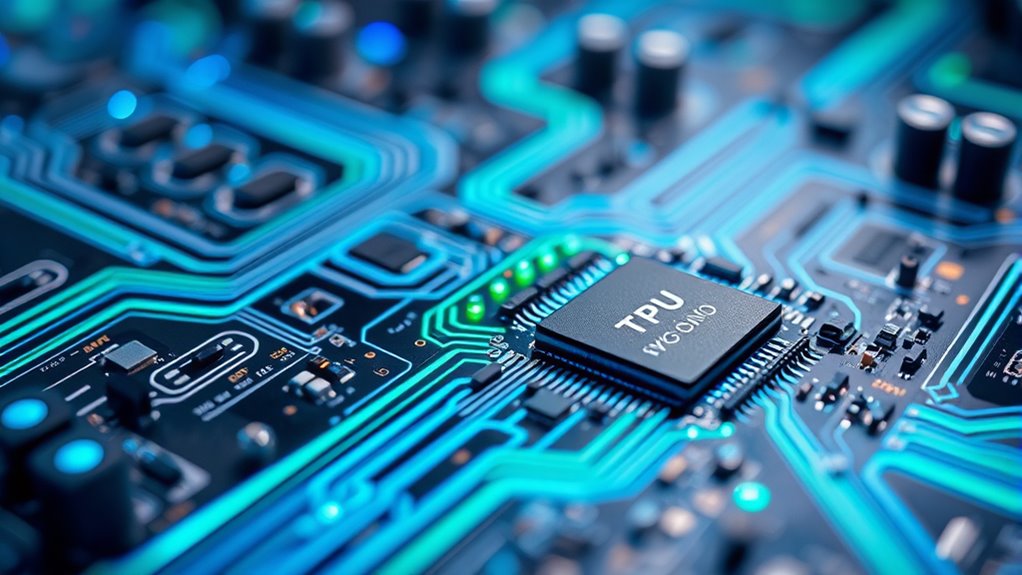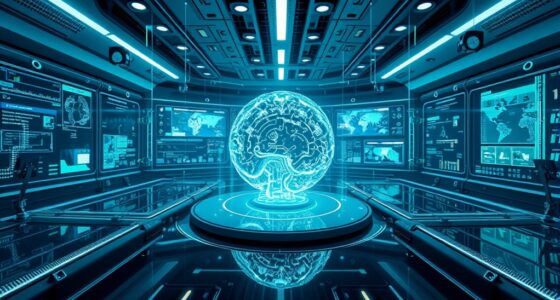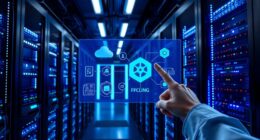Choosing the best edge AI accelerator depends on your needs. TPUs and NPUs excel at powering neural network inference efficiently and with lower power consumption, making them ideal for optimized AI tasks at the edge. GPUs offer more flexibility for diverse AI workloads and scalability. To determine which suits your application best, consider their core strengths. Keep exploring to discover how each technology can elevate your AI solutions even further.
Key Takeaways
- TPUs and NPUs are optimized for high-efficiency neural network inference at the edge, prioritizing power efficiency and performance.
- GPUs offer greater flexibility for diverse AI workloads but may consume more power compared to specialized accelerators.
- TPUs excel in matrix-heavy tasks, providing faster neural network processing with lower latency at the edge.
- NPUs are tailored for neural networks with advanced architecture search, balancing efficiency and adaptability.
- The choice depends on specific application needs: high throughput and power efficiency favor TPUs/NPUs, while flexibility favors GPUs.

Edge AI accelerators are specialized hardware devices designed to bring AI processing closer to data sources, such as sensors and IoT devices. These accelerators are essential for handling complex AI tasks at the edge, reducing latency, and decreasing reliance on cloud infrastructure. When choosing between options like TPU, NPU, or GPU, understanding their core strengths is fundamental. Each type has unique capabilities tailored to different applications, but your focus should be on how well they optimize neural networks and manage power efficiency.
Neural network optimization is fundamental in edge AI, as it ensures models run smoothly and efficiently within hardware constraints. TPUs, or Tensor Processing Units, are designed to accelerate tensor operations, which are central to neural networks. They excel at optimizing neural network performance by leveraging specialized hardware pipelines that streamline matrix multiplications and convolutions. This not only speeds up inference but also enhances the overall efficiency of neural network execution. NPUs, or Neural Processing Units, are explicitly built for neural network tasks, often integrating advanced neural architecture search techniques to optimize models for specific hardware. They excel at neural network optimization by providing tailored instruction sets that reduce computational overhead, making them highly effective for edge devices with limited resources.
GPUs, originally developed for graphics rendering, have evolved into versatile AI accelerators capable of handling a wide range of deep learning workloads. They provide high parallelism, which is critical for training and inference, but their general-purpose design means they typically consume more power compared to TPUs and NPUs. When considering power efficiency techniques, TPUs and NPUs often have an advantage, as they are engineered to maximize performance per watt. Power efficiency is essential at the edge, where devices operate with limited energy supplies and thermal constraints. TPUs utilize techniques like quantization and reduced precision arithmetic, which lower power consumption without sacrificing model accuracy. NPUs employ similar power-saving approaches, often integrating adaptive voltage and frequency scaling (DVFS) and efficient data movement strategies to minimize energy use. Additionally, advancements in specialized hardware architectures are continually improving the efficiency of edge AI accelerators.
In the end, your choice depends on your specific needs. If you require high throughput for neural network inference with optimized power efficiency, TPUs and NPUs are strong contenders. For more flexible, general-purpose AI workloads, especially if hardware compatibility and scalability matter, GPUs might be the better fit. Each accelerator type has its trade-offs, but understanding their strengths in neural network optimization and power efficiency will guide you toward the best solution for your edge AI deployment.
Frequently Asked Questions
How Do Edge AI Accelerators Impact Device Battery Life?
You might notice that edge AI accelerators impact your device’s battery life mainly through their power consumption and energy efficiency. When these accelerators are optimized, they use less power, extending your device’s battery life. However, less efficient ones can drain your battery faster due to higher power consumption. So, choosing the right accelerator can help balance performance with energy efficiency, ensuring your device runs longer on a single charge.
Are Edge AI Accelerators Suitable for Real-Time Applications?
You’ll find edge AI accelerators suitable for real-time applications because they address latency challenges effectively and boost power efficiency. These accelerators process data locally, reducing delays and ensuring quick responses. Their optimized architecture allows you to run complex AI models with minimal power consumption, making them ideal for applications that demand immediate results. So, yes, they’re a great choice for real-time needs, balancing speed and energy use efficiently.
What Is the Cost Difference Between TPU, NPU, and GPU?
You’re curious about the cost comparison among TPU, NPU, and GPU? Typically, GPUs are more affordable upfront, making them popular for general tasks. NPUs tend to be mid-range, balancing performance and cost. TPUs often come with higher prices due to specialized design and cloud-based access. Your affordability analysis depends on your needs—if budget’s tight, GPUs might be best; for specialized tasks, investing in TPUs could pay off.
Can Edge AI Accelerators Be Integrated Into Existing Systems Easily?
When you consider integrating edge AI accelerators into existing systems, you’ll find that it varies based on compatibility considerations and potential integration challenges. Some accelerators are designed for seamless integration, while others may require additional hardware or software adjustments. To guarantee smooth deployment, you should evaluate your system’s architecture, vendor support, and development resources, making sure the chosen accelerator aligns well with your current setup.
How Do Security Features Vary Across Different Edge AI Accelerators?
You’d be amazed at how security features differ across edge AI accelerators—it’s like comparing fortress walls! Some prioritize robust security protocols and hardware encryption, shielding data with military-grade defenses, while others focus more on speed than security. You need to evaluate each one’s security architecture carefully, ensuring it can handle your sensitive data. Don’t underestimate the importance of hardware encryption and security protocols—they’re your frontline in safeguarding AI at the edge.
Conclusion
When choosing between TPU, NPU, or GPU for edge AI, remember that each excels in different tasks. For instance, edge devices with NPUs can boost efficiency by up to 60% compared to traditional GPUs. This shows how specialized accelerators truly transform performance. Ultimately, your choice depends on your specific needs, but knowing that 70% of edge devices now incorporate AI accelerators highlights their growing importance. Stay informed—you’ll make smarter decisions for your AI projects.









